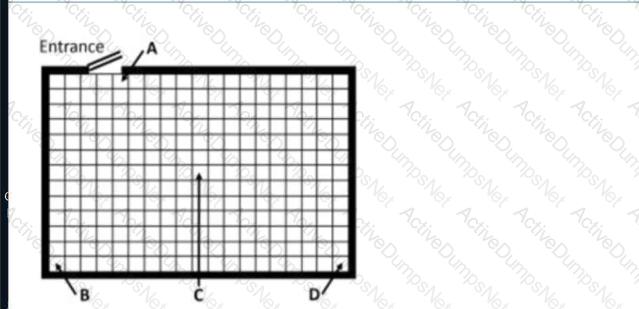EMF shielding material needs to be installed as EMF levels from the transformer room into the computer room are measured at 100 mG. The transformer room is ~10 meters away, separated by a corridor. Where should shielding be installed?
You need to determine the strategy for the cooling audit. All the servers are based on a front-to-rear (F-R) airflow design.
Which location for the temperature/humidity measurement should you recommend for the audit?
What is the minimum requirement for the power feeds to the building for a Rated-3 data center based on the ANSI/TIA-942 standard?
Can you install a raised floor tight to the perimeter of the room?
An air-conditioner unit needs to be selected. Two types are available:
Unit-A has a Sensible Heat Ratio (SHR) of 0.7.
Unit-B has a Sensible Heat Ratio (SHR) of 0.9.
From an efficiency point of view, which one should be selected?
Where should raised-floor installation start?
A new facility requires electrical distribution of 100A to be installed in the computer room, 1 m (3 ft) above sensitive IT equipment. What type of system minimizes EMF impact?
FM-200 is phasing out as a halocarbon gas and management has decided to replace this with the more environmentally friendly Novec-1230 gas. Should you use exactly the same formula and parameters to calculate the gas content for the Novec-1230 gas?
What mainly affects the cooling capacity of a raised floor tile?
You want to manage temperature and humidity only at the facility level in your data center. All servers use front-to-rear airflow. Which location for measurement should you recommend?
What is forced entry resistance based on?
The air intake of the mission-critical server at the top of the rack is measuring 25 °C/77 °F.
Is this acceptable?
Two servers stacked with no gap (metal-to-metal). What heat transfer occurs?
A data center scores Rated-3 in mechanical, Rated-4 in electrical, and Rated-2 in architectural.
What is the overall Rating of this data center when the Rating is based on the ANSI/TIA-942?
What is the main advantage of using an End-of-Row (EoR) design?
Do all residual current devices (RCDs) use the same operating principle?
The temperature in the computer room is increased from 18 °C (64 °F) to 27 °C (81 °F). What is the impact on the amount of gas required to suppress a fire assuming a halocarbon agent?
The computer room has high levels of H2S gas contamination. What is the best option to resolve this issue?
Do you need to consider bullet (ballistics) protection when designing a data center?
Racks with 1.0 m depth and cold aisle containment with 3 perforated tiles are used. What aisle pitch is recommended?
What should be implemented when an Inergen-based fire suppression system is installed in the computer room?
The humidity in the computer room has increased from about 60% up to 85% Relative Humidity (RH). What potential risk does this pose to your equipment?
Where should perforated tiles be installed?
From the options indicated, what is the correct starting point for the raised floor installation?

Do you need to consider blast protection when designing a data center?
When are the wet bulb and dry bulb temperatures identical?
A data center has its own power supply from the public utility and receives chilled water supply from the building owner.
What needs to be taken into consideration when calculating the PUE?
A sprinkler system employs automatic sprinklers attached to a piping system containing water and connected to a water supply so that water discharges immediately when a head opens. What is this called?
It is assumed that EMF shielding material must be installed as the EMF levels coming from the transformer room into the computer room are measured at 100mG. The transformer room is approximately 10 meters away from the computer room and is separated by a corridor. You can assume that no physical issues are present for installing shielding material at any area/location.
Where should you recommend the shielding material to be installed?
An MCB needs to be installed in the PDU of an ICT rack. Which breaking curve should you select?
Smoke sensors must be installed in the computer room. What is the minimum density?
Should aerosol cleaning solutions be used in the computer room?
What is the calculation for the desired attenuation factor for shielding material?
Which efficiency indicator accounts for all cooling costs (installation, operation, disposal)?
In which stage of the data center life cycle does commissioning take place?
Does hot/cold aisle containment impact PUE?